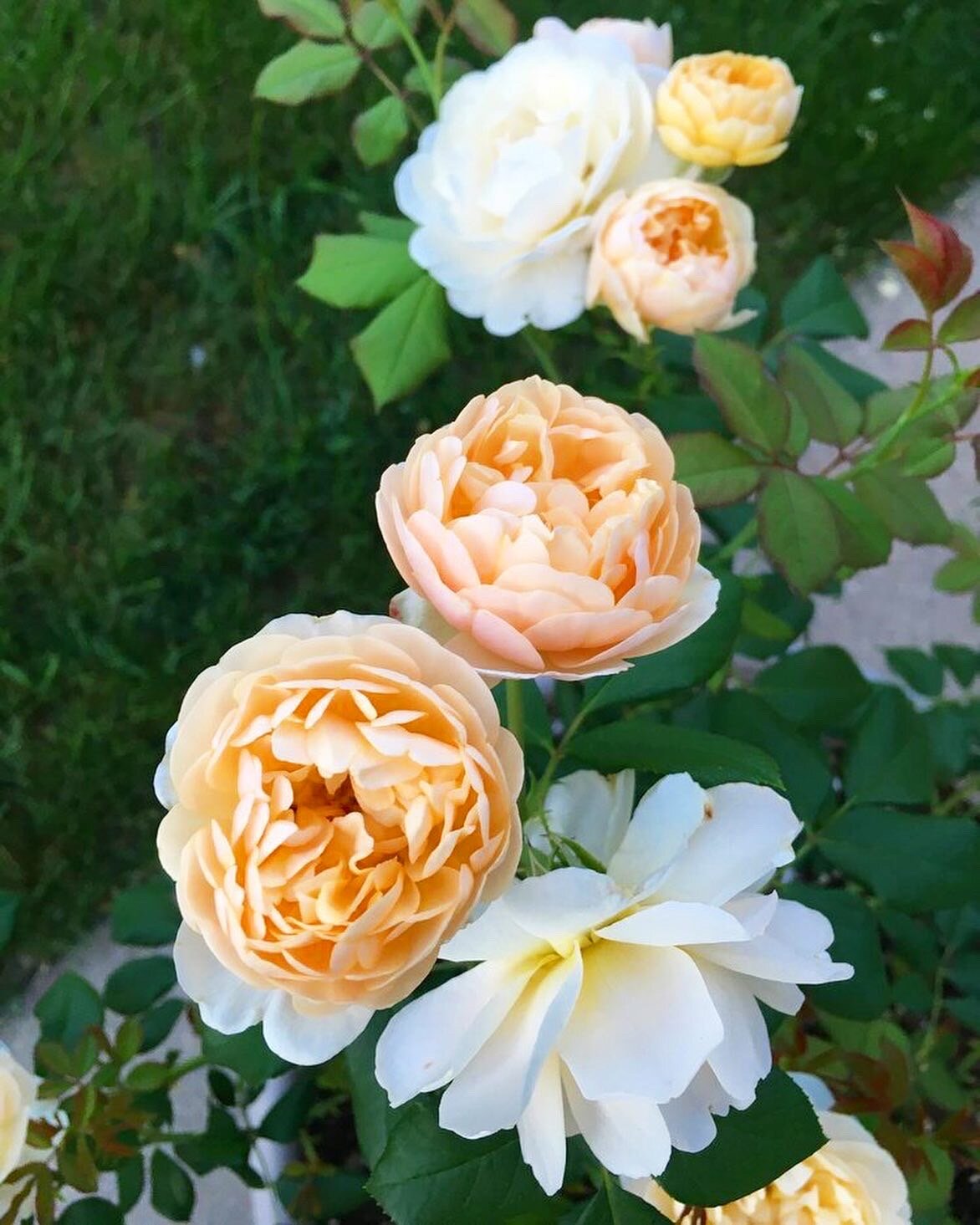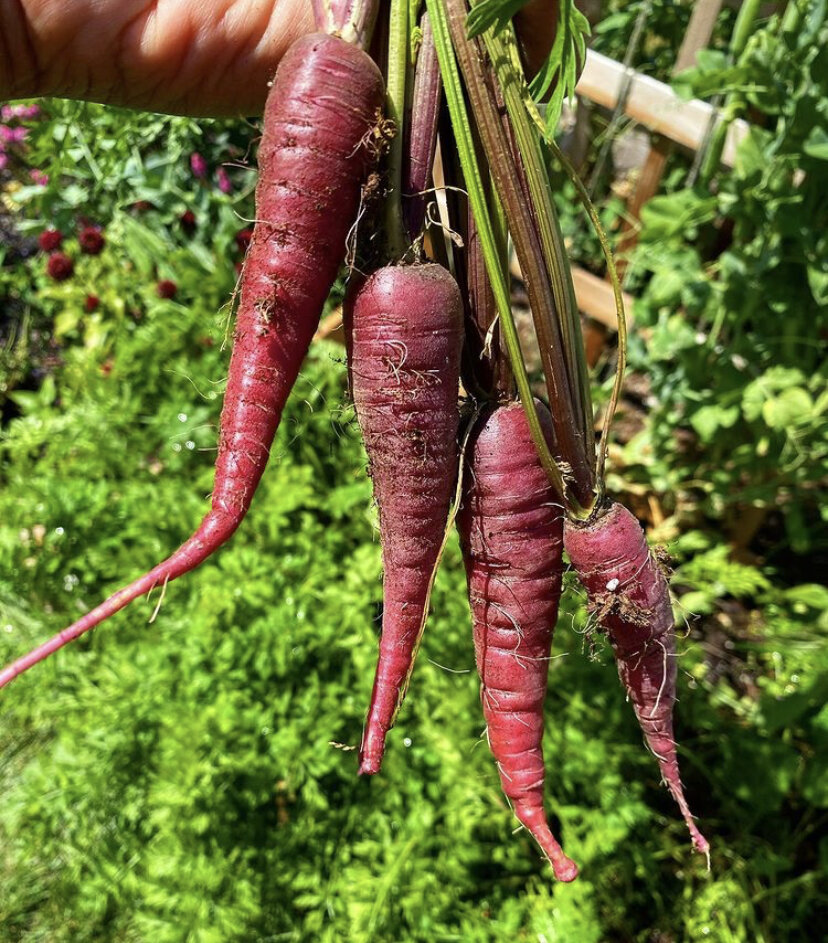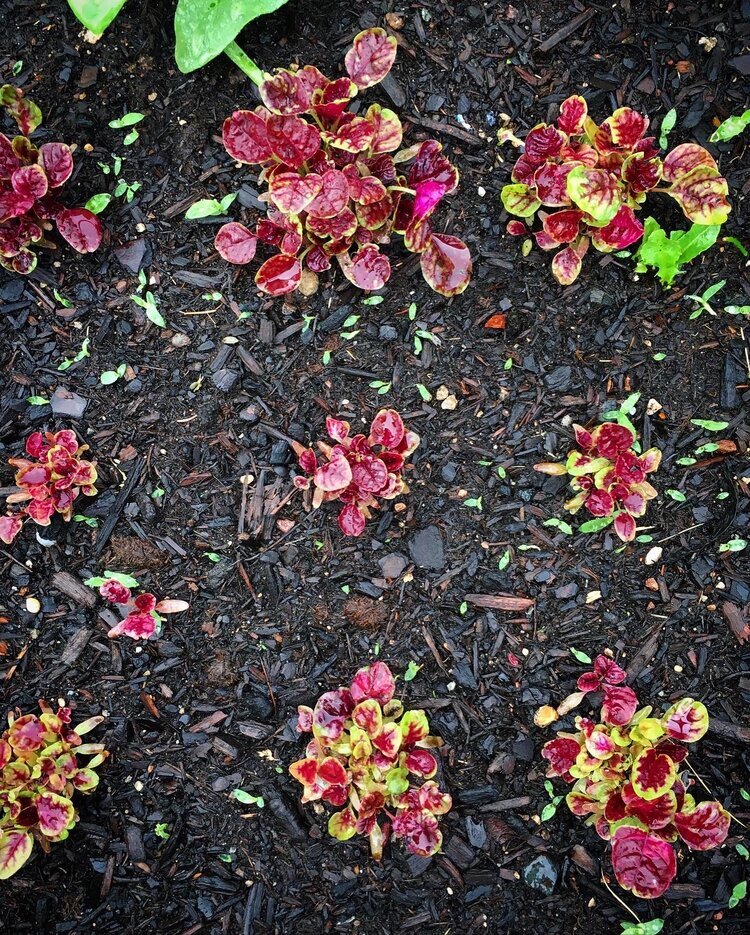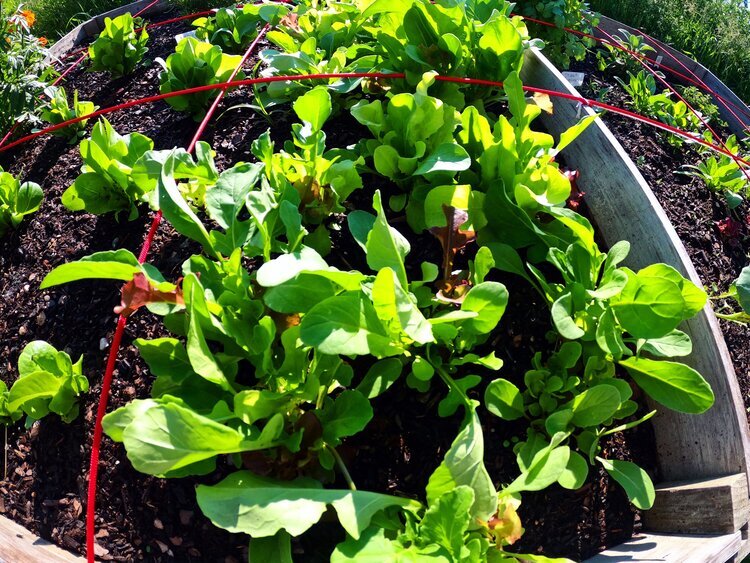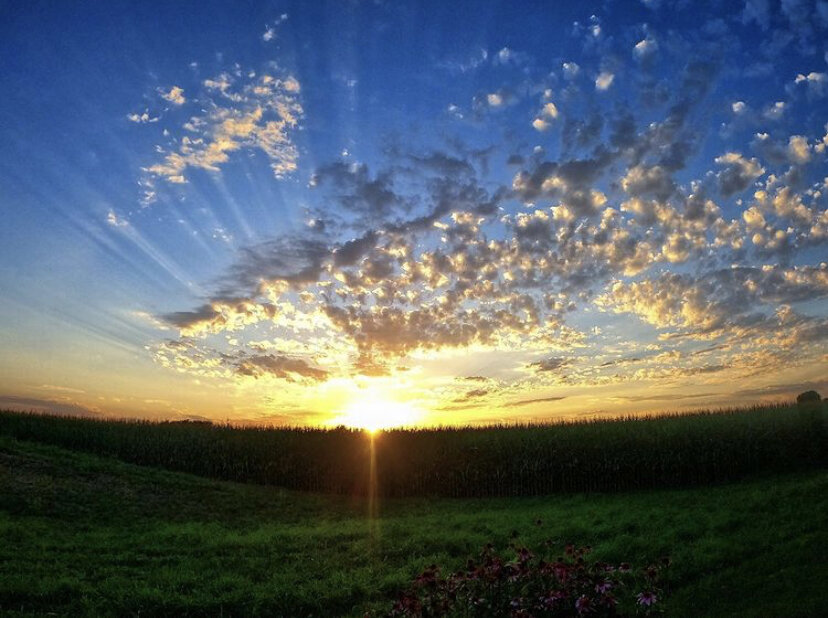2020 was a year of highs and lows. While I was temporarily furloughed during the summer, it allowed me time to focus on things that I love like gardening and my trail running training. If you are a garden lover you can imagine my excitement at the prospect of dedicating unlimited time to my gardening without having to focus on work. :) And so I dove head first into it and had a marvelous time! Below, I share images and summaries of my little garden, and I divided it by sections: the potted rose garden, the little cottage garden, and the kitchen garden, as well as some rookie mistakes I made and one of the “hobbies” I took during quarantine— the houseplant “crazy plant lady” syndrome. This is a fairly long post, but it was much for you, as it was for me to also journal all the work that is put into a garden. I hope you enjoy it!
The Potted Rose Garden
One of the things I knew before the craziness of 2020 started, was that this would be the year of roses for me. For the past three year I dabbled with a couple of David Austin roses and I fell head-over-heels for them. And at the end of the 2019 growing season I ordered five (5) new rose varieties: Heathcliff, Emily Bronte, Wedgwood, Alwick (this was a replacement from a failed one), and Roald Dahl. I also grew Imogen, which was sent to me by mistake, but the good folks at David Austin told me to keep it instead of sending back.
I grow my roses in pots because being in zone 4B with winters where the temperature dips into -35F (with windshield factors of -65F) is brutal for roses. So during the winter, I store them in my unheated garage. When the temperatures dip well below freezing, we have extra heaters to keep the temperature cold but not arctic cold. This year, I am not adding any new roses, as we are building a farmhouse well out in the country.
Scepter’d Isle
Scepter’d Isle
Scepter’d Isle
Imogen
Imogen
Imogen
Alnwick
Wedgwood
Roald Dahl
Roald Dahl
Emily Bronte
Emily Bronte
A few rose highlights:
Best Scent: Emily Bronte. This rose has the most amazing scent of tea with hints of guava and citrus. The scent also feel modern and reminded me of a delicious Jo Malone scent (don’t ask me why). Honorable mention goes to Wedgewood, with its almost paper-like petals and fruity scent. Every time I walked by these two beauties, I had to stop by and inhale the scent.
Best Flowering: Roald Dahl. This was my first yellow/orange rose. I have never been a fan of this color rose, but Roald Dahl won me over. This rose was a blooming workhorse, blooming well into early November. This is a repeat flowering rose, I got three (3) flushes out of this rose. Honorable mention goes to Imogen. She too had repeat flowerings (three of them).
Best Staying Power: Roald Dahl and Emily Bronte. I found these two roses lasted the longest once they bloomed.
Shade tolerant: Wedgwood and Emily Bronte. While roses love sun, these two proved that sometimes a rose will do good in partial to full shade. In my case, we had a brutal summer that I think was cooking the poor dears in their plastic pots. Once I moved them to my front porch, where they got only a few hours of sun, they thrived.
Disappointment No 1: Claire Austin. If there is a rose that continues to break my heart (and I am honestly done with it) is Claire Austin. The first year it failed to come out of dormancy. The next year, DA sent me a replacement, which bloomed beautifully (even though the flowers did not last long). Then last year, when it came out of dormancy it was ok, but did not make it. It was rather heartbreaking because I love the look and the myrrh scent it has.
Disappointment No. 2: Heathcliff. Talk about a disappointment. Again— this one came out of dormancy and them promptly died. I’m baffled because I did exactly as I did with the other four new roses, but this one just did not work out.
Biggest surprise. For all my roses, I stick with the David Austin roses food and it has worked great. But this year, after reading much about it, I added seaweed plant food (I used Neptune’s Harvest), and it kicked these beauties into high gear. For the roses I used a foliar application as kelp extracts are said to be 10-15 times more effective when applied to the leaves than when applied to the soil.
The mini Cottage Garden
What I call the cottage garden, is in the plot of land I cultivate behind our house (between the yard and the crop fields), and it is in the same area where I have my little kitchen garden. This idea grew out of having an empty space and wanting to attract more pollinators. It was the last area I planted and it turned out to be one of my favorite areas to plant. The area already had that vibe thanks to the profusion of Cosmo already growing, and it seemed like a natural progression.
To create that feel, I went with plants that looked informal yet put together. Starting in the back of that garden bed (next to peas trellis) I added (from back to front): Russian sage, Veronica, different varieties of echinacea and scabiosa. Later in the season I filled in the empty spots where you see soil with lemon balm and French thyme. As the summer went along, it filled in beautifully and was a haven for pollinators, especially for black wasps (they are good pollinators) which seemed to love the Veronica. I also grew two new kinds of sunflowers: Teddy Bear and Honey Bee, which were a great hit with bees. As I walked into that little plot area, having the Cosmo on side and the rest of the cottage garden bed on the other, was pure joy and always made me smile. Below, are some images of the flowers planted there.
the kitchen garden
I loved the little kitchen garden area which was inspired by the old Victory Gardens in WW2. Why? I planted this portion during the quarantine time when it was just cumbersome to go to the grocery store. I am mostly vegetarian and I found a ridiculous shortage of produce when I would go to the store. It last for only a short period of time, but I noticed it and it got me thinking about food security. This was such a rewarding part of gardening because once it got going, I had produce all the way through the fall. Note: most of these photos were taken at the beginning of the growing season.
I used the square-foot method of gardening which is a simple method of creating small, orderly, and highly productive kitchen gardens. It was invented by backyard gardener, retired engineer, and efficiency expert Mel Bartholomew as a better way to grow a vegetable garden, and it became a huge hit when he introduced the idea to the gardening public in 1981 in his book Square Foot Gardening (Goodhouse Keeping). I wrote a post about it HERE.
In this garden I planted things I normally eat and I stuck with heirloom seeds (which I normally get from Baker Creek Heirloom Seeds). From top left to right: borage, rosemary, thyme, cilantro, sage, and oregano. Middle left to right: marigolds, ‘Tom Thumb’ lettuce, mesclun classic mix, romanesco broccoli, ‘Bloomsdale Longstanding Spinach’ and more marigolds. Bottom left to right: calendula, ‘Tom Thumb’ lettuce and mesclun, romanesco broccoli, ‘Chinese Multicolor Spinach’ (it is actually a leaf amaranth), and calendula.
The herbs and flowers were planted as companion plants to deter pests and it worked for the most part. The herbs grew ridiculously fast and big, which is a great problem to have as you can freeze the majority of the herbs. In a separate garden bed next to the cottage garden one I planted peas, Purple Teepee bush beans (extremely prolific), and Purple Dragon carrots (which are ridiculously delicious!). In all this was a very rewarding experience and next year, the kitchen garden is coming back.
Purple Dragon Carrots
Mesclun mix
Chinese Multicolor Spinach
I could not keep up with how fast the mesclun mix was growing!
Purple Teepee beans
Herbs galore!
Rookie Mistakes
Of course, along the way I learned valuable lessons thanks to rookie mistakes because it was the first time I grew a veggie garden or a flower. Whether it was about underestimating the spacing and number of plants in one area, or growing habits, it made for some fun times.
The legumes and carrots bed was overflowing with goodness, which is not necessarily, a good thing. The bush beans are very leafy and started crowding the carrots and the bottom of the peas. I found myself having to think some areas multiple times during the season.
Planting rosemary and borage next to each other is not a bad thing, but I made the mistake of neglecting my garden for a couple of weeks and when I came out, the borage and rosemary bush were definitely not practicing social distancing.
Flowers like salvia, chamomile and marigolds just took over the areas they were planted in and more. Again— research their growth habit.
A tangled legume mess.
Holy borage and rosemary!
Salvia
German chamomile
Marigolds in the background
Quarantine Crazy Plant Lady
Without a doubt the funniest thing that happened, gardening-wise, during quarantine was that I became an official crazy plant lady. I had three houseplants before all the craziness started, and now I own about 17 houseplants. It got so crazy that my husband bought me a shelving unit that now sits in front of our dining room’s south facing window, and my babies are loving it. To keep busy and meet my Master Gardener volunteer hours, I took a few online courses, and one of them was Hilton Carter course on propagating plants. Of all the courses I took, this is the one I have used the most. And one of the reasons I have even more plants.
Growing tropical houseplants has been interesting to me because growing up in Puerto Rico, we had many of these tropical plants growing in the outdoors, But trying to keep them alive indoors during the cold Minnesota winter is going to be a test. More to follow.
Snake Plant
Calathea Lancifolia - Rattlesnake Plant
Maranta (Prayer plant) propagation station
Staghorn Fern
Bunny Ears cactus propagated.
And last but not least, I wanted to share one of the most exciting things that happened during quarantine— I (along with some of our master gardeners) started writing a column for our local newspaper with garden tips and answering questions from readers, and it has been lots of fun. 2020 was my first year as a Master Gardener (not just an intern) and I was so excited about all the projects I wanted to work on. Sadly, because of COVID, a lot of that came to a screeching halt. So this opportunity to share our love for gardening was a heaven sent,. With this in mind, I am going into 2021 full of hope that no matter what happens, I will always have my garden. It is my happy place, my sanctuary, my gym, and my favorite place to be. Here is to new beginnings armed with faith, love and kindness. Happy New Year, my friends!
You may find me joining some of these fun link-ups: In a Vase on Monday, Mosaic Monday, Friday Bliss, Home and Garden Thursday, Pink Saturday, Nature Notes, Dishing It & Digging It, Thankful Thursday, Grace at Home, Wonderful Wednesday Blog-Hop











